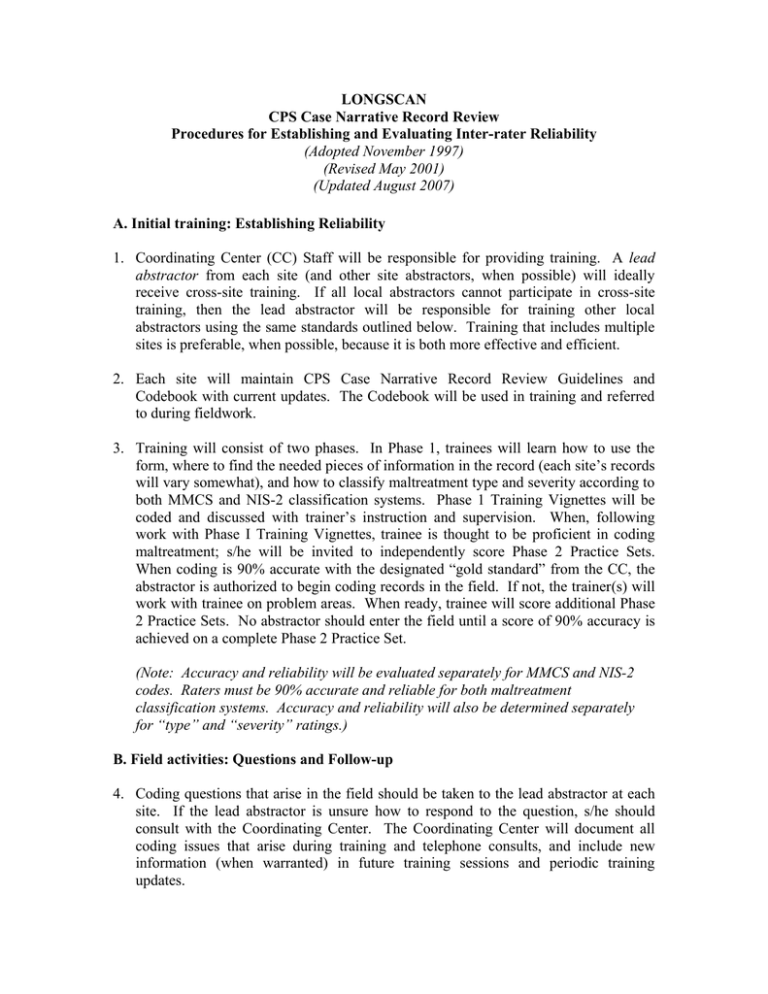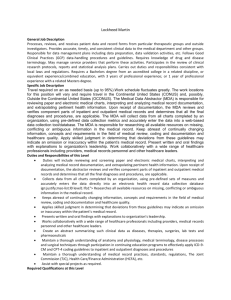LONGSCAN CPS Case Narrative Record Review Procedures for
advertisement

LONGSCAN CPS Case Narrative Record Review Procedures for Establishing and Evaluating Inter-rater Reliability (Adopted November 1997) (Revised May 2001) (Updated August 2007) A. Initial training: Establishing Reliability 1. Coordinating Center (CC) Staff will be responsible for providing training. A lead abstractor from each site (and other site abstractors, when possible) will ideally receive cross-site training. If all local abstractors cannot participate in cross-site training, then the lead abstractor will be responsible for training other local abstractors using the same standards outlined below. Training that includes multiple sites is preferable, when possible, because it is both more effective and efficient. 2. Each site will maintain CPS Case Narrative Record Review Guidelines and Codebook with current updates. The Codebook will be used in training and referred to during fieldwork. 3. Training will consist of two phases. In Phase 1, trainees will learn how to use the form, where to find the needed pieces of information in the record (each site’s records will vary somewhat), and how to classify maltreatment type and severity according to both MMCS and NIS-2 classification systems. Phase 1 Training Vignettes will be coded and discussed with trainer’s instruction and supervision. When, following work with Phase I Training Vignettes, trainee is thought to be proficient in coding maltreatment; s/he will be invited to independently score Phase 2 Practice Sets. When coding is 90% accurate with the designated “gold standard” from the CC, the abstractor is authorized to begin coding records in the field. If not, the trainer(s) will work with trainee on problem areas. When ready, trainee will score additional Phase 2 Practice Sets. No abstractor should enter the field until a score of 90% accuracy is achieved on a complete Phase 2 Practice Set. (Note: Accuracy and reliability will be evaluated separately for MMCS and NIS-2 codes. Raters must be 90% accurate and reliable for both maltreatment classification systems. Accuracy and reliability will also be determined separately for “type” and “severity” ratings.) B. Field activities: Questions and Follow-up 4. Coding questions that arise in the field should be taken to the lead abstractor at each site. If the lead abstractor is unsure how to respond to the question, s/he should consult with the Coordinating Center. The Coordinating Center will document all coding issues that arise during training and telephone consults, and include new information (when warranted) in future training sessions and periodic training updates. 5. Once in the field, after having coded the first 50 records, a third set of 10 gold standard vignettes should be scored by the abstractor. Again, 90% accuracy with the gold standard is required. If the abstractor is not 90% accurate, s/he will be re-trained and re-tested until 90% accuracy is reached. (Also the 50 records just coded should be reviewed and recoded.) This process will be repeated again after another 100 records have been coded. (In this case, if accuracy is below 90%, only the 100 records just coded should be reviewed and recoded, following retraining.) C. Field activities: Ongoing inter-rater reliability 6. In addition to initially establishing reliability during training and in the field, each abstractor (including lead abstractors) is to be periodically assessed in terms of interrater reliability of their coding and abstraction work. This process will use actual reports from CPS records – narratives of allegations and of substantiations - rather than “gold standard vignettes.” 7. Periodically, a 10% sample of allegation and substantiation narratives will be randomly selected by the CC. These will be sent to each abstractor for coding of maltreatment type and severity according to both MMCS and NIS-2 maltreatment classification systems. Inter-rater reliability kappa statistics will be calculated by abstractor, site and study overall. 8. If an abstractor/coder is not 90% reliable, s/he will be re-trained and re-tested until 90% reliability is achieved.


